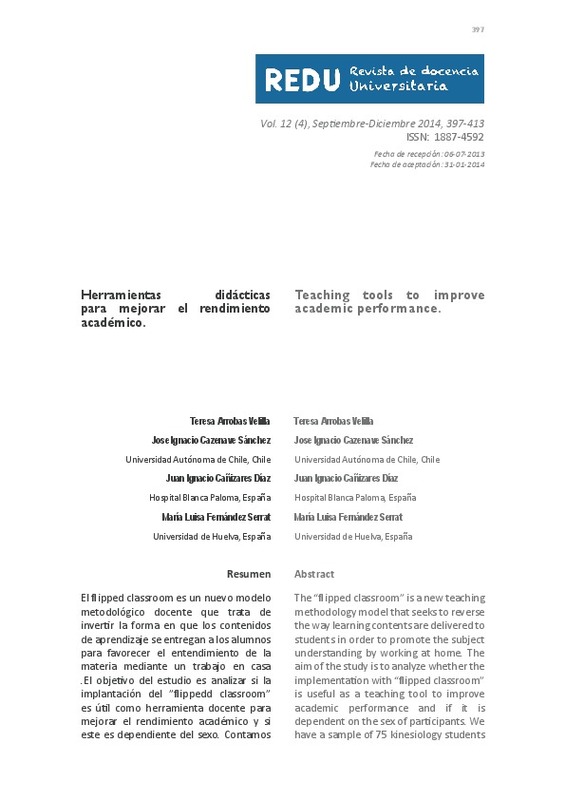Bergmann, J. (2012). Flip Your Classroom: Talk To Every Student In Every Class Every Day Author: Jonathan Bergmann, Aaron Sams, Publisher: Inte.
Bligh, D. A. (1972). What's the Use of Lectures? (pp. 21-43). Harmondsworth: Penguin.
Bloom, B. S., Engelhart, M. D., Furst, E. J., Hill, W. H., & Krathwohl, D. R. (1956). Taxonomy of educational objectives: Handbook I: Cognitive domain. New York: David McKay, 19, 56.
[+]
Bergmann, J. (2012). Flip Your Classroom: Talk To Every Student In Every Class Every Day Author: Jonathan Bergmann, Aaron Sams, Publisher: Inte.
Bligh, D. A. (1972). What's the Use of Lectures? (pp. 21-43). Harmondsworth: Penguin.
Bloom, B. S., Engelhart, M. D., Furst, E. J., Hill, W. H., & Krathwohl, D. R. (1956). Taxonomy of educational objectives: Handbook I: Cognitive domain. New York: David McKay, 19, 56.
Bonwell, C. C., & Sutherland, T. E. (1996). The active learning continuum: Choosing activities to engage students in the classroom. New Directions for Teaching and Learning, 1996(67), 3-16.
Bunce, D., Flens, E., Neiles, K. (2011).How long can students pay attention in class? A study of student attention decline using clickers. J Chem Educ 87:1438-1443.
Carbone, E. (1998). Teaching large classes: Tools and strategies (Vol. 19). Sage.
Chesapeake, VA: AACE. Retrieved from http://www.editlib.org/p/39738Michele Houston, Lin Lin, University of North Texas, United States
Chickering, A., and Zelda FG(1987). Seven principles for good practice. American Association for Higher Education Bull 39 (7): 3±7.
Demetry, C. Work in progress - An innovation merging -classroom flip‖ and teambased learning Published in: Frontiers in Education Conference (FIE), 2010 IEEE .Date of Conference: 27-30 Oct. 2010 .Page(s):T1E-1 - T1E-2 ISSN :0190-5848
Houston, M.,Lin, L. (2012). Humanizing the Classroom by Flipping the Homework versus Lecture Equation. En P. Resta (Ed.), Proceedings of Society for Information Technology & Teacher Education International Conference 2012 (pp. 1177-1182).
Herreid, C. F. (2002) Using Case Studies in Science-And Still Covering Content. In Team Based Learning: A Transformative Use of Small Groups (Ed. L. Michaelson, A. Knight & L. Fink) Praeger, Westport, Conn., pp.109-118.
Koman K. Newton, 1998. Última fecha de acceso. 14.08.2013. Available: http:// www. columbia.edu/cu/gsapp/BT/RESEARCH/mazur.html.
Lage, M. J., Platt, G. J., & Treglia, M. (2000). Inverting the classroom: A gateway to creating an inclusive learning environment. The Journal of Economic Education, 31(1), 30- 43.
Lindquist, S. I., & McLean, J. P. (2011). Daydreaming and its correlates in an educational environment. Learning and Individual Differences, 21(2), 158-167.
Novak, G. M., Patterson, E. T., Gavrin, A., & Enger, R. C. (1998, May). Just-in-Time Teaching: Active learner pedagogy with WWW. In IASTED International Conference on Computers and Advanced Technology in Education (pp. 27-30).
Pastötter, B., Schicker, S., Niedernhuber, J., & Bäuml, K. H. T. (2011). Retrieval during learning facilitates subsequent memory encoding. Journal of Experimental Psychology: Learning, Memory, and Cognition, 37(2), 287.
Rao, S. P., & DiCarlo, S. E. (2000). Peer instruction improves performance on quizzes. Advances in Physiology Education, 24(1), 51-55.
Redish, F ., Rigden, J.( 1997). Getting students to think in class‖. En E.Mazur, Peer instruction ( pp. 981-988) .New York: Ed. Edward
Risko, E. F., Anderson, N., Sarwal, A., Engelhardt, M., & Kingstone, A. (2012). Everyday attention: variation in mind wandering and memory in a lecture. Applied Cognitive Psychology, 26(2), 234-242.
Ruddick, K. W. (2012). Improving chemical education from high school to college using a more hands-on approach.
Smallwood, J., McSpadden, M., & Schooler, J. W. (2008). When attention matters: The curious incident of the wandering mind. Memory & Cognition, 36(6), 1144-1150.
Smallwood, J., Schooler, J. (2006) .The restless mind. Psychol Bull 132(6):946-958
Smallwood, J., Baracaia, SF., Lowe, M., Obonsawin, M. (2003) Task unrelated thought whilst encoding information. Conscious Cogn 12(3):452-484.
Szpunar, K. K., Khan, N. Y., & Schacter, D. L. (2013). Interpolated memory tests reduce mind wandering and improve learning of online lectures. Proceedings of the National Academy of Sciences, 110(16), 6313-6317.
Wilson, K., & Korn, J. H. (2007). Attention during lectures: Beyond ten minutes. Teaching of Psychology, 34(2), 85-89.
Zappe, S., Leicht, R., Messner, J., Litzinger, T., & Lee, H. W. (2009). Flipping" the classroom to explore active learning in a large undergraduate course. In American Society for Engineering Education. American Society for Engineering Education.
[-]








